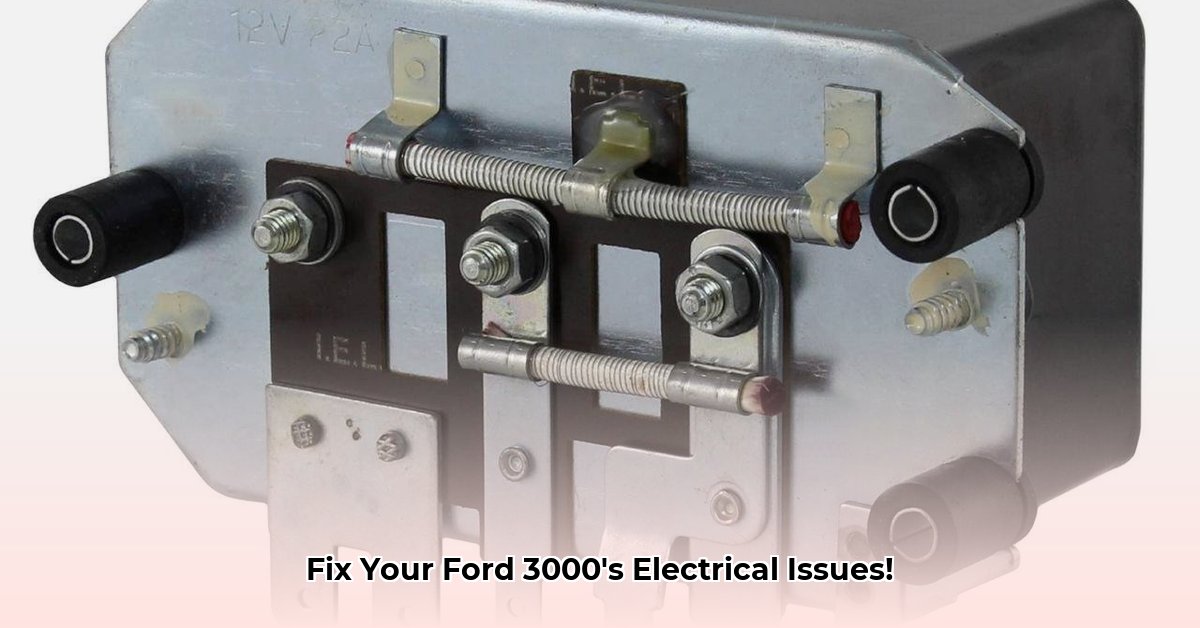
Keeping your Ford 3000 tractor running smoothly depends on a healthy electrical system. A faulty voltage regulator can cause significant issues, from dimming lights to complete engine failure. This guide provides step-by-step instructions for replacing your voltage regulator, along with troubleshooting tips and preventative maintenance advice. Let's get your Ford 3000 back in top working order! For more Ford 3000 resources, check out this helpful website.
Identifying a Problematic Voltage Regulator
Before replacing parts, confirm the voltage regulator is the problem. Common symptoms include:
- Dimming lights: Noticeably fainter lights indicate a potential voltage problem.
- Difficult starting: Struggling to start the tractor often points to insufficient battery charge, frequently linked to a failing voltage regulator.
- Battery issues: Consistent overcharging (damaging the battery) or undercharging (dead battery) strongly suggests a faulty voltage regulator.
A multimeter can verify voltage levels. If you're unsure, a mechanic familiar with Ford 3000 tractors can accurately diagnose the issue.
Locating and Choosing a Replacement
Once a faulty regulator is confirmed, finding a replacement is straightforward. Several options exist:
- Online Retailers: Major sites like Amazon and eBay offer Ford 3000 parts, including voltage regulators. Check reviews carefully.
- Specialty Tractor Parts Suppliers: These suppliers often carry a wider selection and offer expert advice.
- Local Tractor Repair Shops: Local shops provide parts and advice, often having parts in stock.
When choosing, consider:
- Brand Reputation: Select established brands known for reliability.
- Price: Compare prices while prioritizing quality.
- Warranty: A warranty offers essential peace of mind.
- Amperage Rating: Match the new regulator's amperage rating to your Ford 3000's specifications. Incorrect amperage can cause damage.
- OEM vs. Aftermarket: OEM (Original Equipment Manufacturer) parts are usually more expensive but potentially more reliable. Reputable aftermarket parts offer a cost-effective alternative.
Consult your Ford 3000's service manual for precise specifications and part numbers.
Step-by-Step Replacement: A Practical Guide
Replacing the voltage regulator is manageable. However, careful attention to detail is crucial.
Step 1: Safety First! Always disconnect the negative (-) battery terminal before working on any electrical components.
Step 2: Locate the Regulator: Find the regulator; usually near the battery or mounted on the fender. Refer to your service manual if needed.
Step 3: Disconnect Wiring: Carefully disconnect wires, photographing or diagramming connections for easy reassembly.
Step 4: Remove the Old Regulator: Unscrew and remove the old regulator.
Step 5: Install the New Regulator: Secure the new regulator in place.
Step 6: Reconnect Wiring: Reconnect wires according to your diagram.
Step 7: Reconnect the Battery: Connect the negative (-) terminal first, then the positive (+).
Step 8: Test: Start the tractor and check voltage; lights should be bright, and the battery should charge correctly.
Preventative Maintenance: Extending System Lifespan
Regular maintenance prevents problems and extends your tractor’s electrical system life.
- Visual Inspection: Regularly check for damage, corrosion, loose connections, or overheating.
- Voltage Checks: Periodic voltage testing keeps the system's performance in check.
- Connection Cleaning: Clean corroded connections with a wire brush and apply a corrosion inhibitor.
Troubleshooting Common Issues
Even with a new regulator, problems can persist.
- Check Connections: Thoroughly inspect all connections for loose wires or corrosion.
- Test Voltage: Take voltage readings to pinpoint problem areas.
- Inspect Wiring Harness: If issues remain, examine the wiring harness for damage.
If uncomfortable, consult a qualified mechanic for electrical system work.
Choosing the Best Replacement: Regulator vs. Alternator Conversion
The original Ford 3000 voltage regulator is known for failure. While a replacement regulator is a simpler solution, its longevity is limited; cheap regulators often fail quickly. A point adjustment might provide a temporary fix, but it addresses only symptoms. The superior, long-term solution is an alternator conversion. This is more complex but offers lasting reliability and consistent performance.
The best choice depends on your skills, budget, and long-term needs. Prioritize quality when choosing a replacement.
Comparing Options:
| Feature | Replacement Voltage Regulator | Alternator Conversion |
|---|---|---|
| Cost | Low initial cost | Higher initial cost |
| Reliability | Low | High |
| Longevity | Short lifespan | Long lifespan |
| Complexity | Relatively simple | More complex, requires specialized knowledge and skills |
| Long-term cost | High | Low |
Regardless of choice, regular preventative maintenance is crucial. Clean battery terminals, check wiring, and monitor charging systems to maximize lifespan.